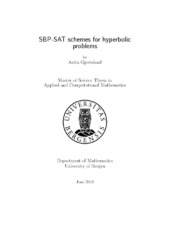SBP-SAT schemes for hyperbolic problems
Master thesis
Permanent lenke
https://hdl.handle.net/1956/19980Utgivelsesdato
2019-06-13Metadata
Vis full innførselSamlinger
- Master theses [120]
Sammendrag
Numerical methods for solving partial differential equations is an important field of study, as it helps us to describe many different processes in the world. An important property of a numerical method, is that it should be a stable approximation of the governing differential equation. For numerical approximations that satisfy a summation-by-parts rule, and that are combined with the simultaneous approximation term technique at the boundaries, energy estimates can be derived to prove stability. The Summation-By-Parts Simultaneous Approximation Term (SBP-SAT) technique was first developed in the context of the finite difference method. More recently, it has been shown that other numerical methods, such as the finite volume method, also can be formulated in the SBP framework. The finite volume method is a popular numerical method, as it can be formulated on unstructured grids. However, Svärd et al. ([1]) showed that some approximations of the second derivative are in fact inconsistent on such grids. Consistency is another key feature of a numerical method. The method should be consistent in order for us to know that we are solving the correct equation. In this thesis, we study the extension of the SBP-SAT technique to the finite volume method. We introduce a methodology for implementing a second derivative approximation on general unstructured grids by including a transformation to a computational domain, where accuracy is expected to be recovered. The numerical experiments demonstrate that full accuracy is not obtained when including the transformation. There are still nodes along and near the boundary that are inconsistent. However, numerical experiments indicate that we have convergence. [1]: M. Svärd, J. Gong, and J. Nordström. An accuracy evaluation of unstructured node-centred finite volume methods. Applied Numerical Mathematics, 58:1142–1158, 2007. doi: 10.1016/j.apnum.2007. 05.002.
